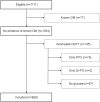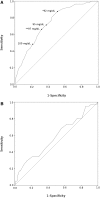Undiagnosed diabetes in kidney transplant candidates: a case-finding strategy
- PMID: 20133490
- PMCID: PMC2849698
- DOI: 10.2215/CJN.07501009
Undiagnosed diabetes in kidney transplant candidates: a case-finding strategy
Abstract
Background and objectives: Guidelines recommend that candidates for kidney transplantation (KTx) who do not have diabetes perform a pretransplantation oral glucose tolerance test (OGTT) when fasting plasma glucose (FPG) is <110 mg/dl (<6.1 mmol/L); however, the OGTT is potentially costly and cumbersome. We studied the role of the OGTT for diagnosing diabetes and the accuracy of FPG and glycated hemoglobin (HbA(1c)) for predicting a diabetic OGTT before KTx.
Design, setting, participants, & measurements: In this cross-sectional study, 889 first single-kidney transplant candidates without diabetes, mainly white, performed an OGTT during the transplantation workup. Results were studied using receiver operating characteristic analysis.
Results: Of 72 (8.1%) patients with undiagnosed diabetes, only 16 (22%) had a diabetic FPG (> or =126 mg/dl [> or =7.0 mmol/L]). In patients with a nondiabetic FPG, diabetes (2-hour plasma glucose [2h-PG] > or =200 mg/dl [> or =11.1 mmol/L]) was predicted by FPG but not by HbA(1c). Performing the OGTT in patients with FPG 92 to 125 mg/dl (5.1 to 6.9 mmol/L) identified 65 (90%) patients with diabetes (16 by FPG, 49 by 2h-PG) and required seven OGTTs per patient identified. Subjecting all patients with FPG <110 mg/dl (<6.1 mmol/L) to the OGTT identified 60 (83%) patients with diabetes (16 by FPG, 44 by 2h-PG) but required 14 OGTTs per patient.
Conclusions: The OGTT was paramount in finding most cases of undiagnosed diabetes before KTx. FPG but not HbA(1c) predicted a diabetic OGTT. We suggest that white KTx candidates without diabetes perform a pretransplantation OGTT when FPG is 92 to 125 mg/dl (5.1 to 6.9 mmol/L).
Figures


Similar articles
-
A large proportion of prediabetes and diabetes goes undiagnosed when only fasting plasma glucose and/or HbA1c are measured in overweight or obese patients.Diabetes Metab. 2010 Sep;36(4):312-8. doi: 10.1016/j.diabet.2010.02.004. Diabetes Metab. 2010. PMID: 20627649
-
Fasting plasma glucose and glycosylated hemoglobin in the screening for diabetes mellitus after renal transplantation.Transplantation. 2009 Aug 15;88(3):429-34. doi: 10.1097/TP.0b013e3181af1f53. Transplantation. 2009. PMID: 19667949
-
Combined use of a fasting plasma glucose concentration and HbA1c or fructosamine predicts the likelihood of having diabetes in high-risk subjects.Diabetes Care. 1998 Aug;21(8):1221-5. doi: 10.2337/diacare.21.8.1221. Diabetes Care. 1998. PMID: 9702423
-
Fasting Plasma Glucose and the HbA1c Are Not Optimal Screening Modalities for the Diagnosis of New Diabetes in Previously Undiagnosed Asian Indian Community Participants.Ethn Dis. 2018 Feb 1;28(1):19-24. doi: 10.18865/ed.28.1.19. eCollection 2018 Winter. Ethn Dis. 2018. PMID: 29467562 Free PMC article.
-
Time-saving screening for diabetes in patients with coronary artery disease: a report from EUROASPIRE IV.BMJ Open. 2016 Dec 8;6(12):e013835. doi: 10.1136/bmjopen-2016-013835. BMJ Open. 2016. PMID: 27932342 Free PMC article.
Cited by
-
Validation of diagnostic utility of fasting plasma glucose and HbA1c in stable renal transplant recipients one year after transplantation.BMC Nephrol. 2019 Jan 10;20(1):12. doi: 10.1186/s12882-018-1171-3. BMC Nephrol. 2019. PMID: 30630438 Free PMC article.
-
Diabetes in Kidney Transplantation.Adv Chronic Kidney Dis. 2021 Nov;28(6):596-605. doi: 10.1053/j.ackd.2021.10.004. Adv Chronic Kidney Dis. 2021. PMID: 35367028 Free PMC article. Review.
-
Nodular glomerulosclerosis in a kidney transplant recipient with impaired glucose tolerance: diabetic or idiopathic? A case report and literature review.CEN Case Rep. 2021 May;10(2):273-280. doi: 10.1007/s13730-020-00546-x. Epub 2021 Jan 3. CEN Case Rep. 2021. PMID: 33393072 Free PMC article. Review.
-
Diabetes Mellitus Following Renal Transplantation: Clinical and Pharmacological Considerations for the Elderly Patient.Drugs Aging. 2017 Aug;34(8):589-601. doi: 10.1007/s40266-017-0478-2. Drugs Aging. 2017. PMID: 28718072 Review.
-
New-onset diabetes after kidney transplant in children.Pediatr Nephrol. 2015 Mar;30(3):405-16. doi: 10.1007/s00467-014-2830-7. Epub 2014 Jun 4. Pediatr Nephrol. 2015. PMID: 24894384 Review.
References
-
- Vincenti F, Friman S, Scheuermann E, Rostaing L, Jenssen T, Campistol JM, Uchida K, Pescovitz MD, Marchetti P, Tuncer M, Citterio F, Wiecek A, Chadban S, El-Shahawy M, Budde O, Goto N: Results of an international, randomized trial comparing glucose metabolism disorders and outcome with cyclosporine versus tacrolimus. Am J Transplant 7: 1506–1514, 2007 - PubMed
-
- Lin-Tan DT, Lin JL, Wang LH, Wang LM, Huang LM, Liu L, Huang JY, Huang YL: Fasting glucose levels in predicting 1-year all-cause mortality in patients who do not have diabetes and are on maintenance hemodialysis. J Am Soc Nephrol 18: 2385–2391, 2007 - PubMed
-
- Mathew JT, Rao M, Job V, Ratnaswamy S, Jacob CK: Post-transplant hyperglycaemia: A study of risk factors. Nephrol Dial Transplant 18: 164–171, 2003 - PubMed
-
- Nam JH, Mun JI, Kim SI, Kang SW, Choi KH, Park K, Ahn CW, Cha BS, Song YD, Lim SK, Kim KR, Lee HC, Huh KB: Beta-cell dysfunction rather than insulin resistance is the main contributing factor for the development of postrenal transplantation diabetes mellitus. Transplantation 71: 1417–1423, 2001 - PubMed
-
- Ramesh Prasad GV, Huang M, Bandukwala F, Nash MM, Rapi L, Montada-Atin T, Meliton G, Zaltzman JS: Pre-transplantation glucose testing for predicting new-onset diabetes mellitus after renal transplantation. Clin Nephrol 71: 140–146, 2009 - PubMed
Publication types
MeSH terms
Substances
LinkOut - more resources
Full Text Sources
Medical
Miscellaneous

